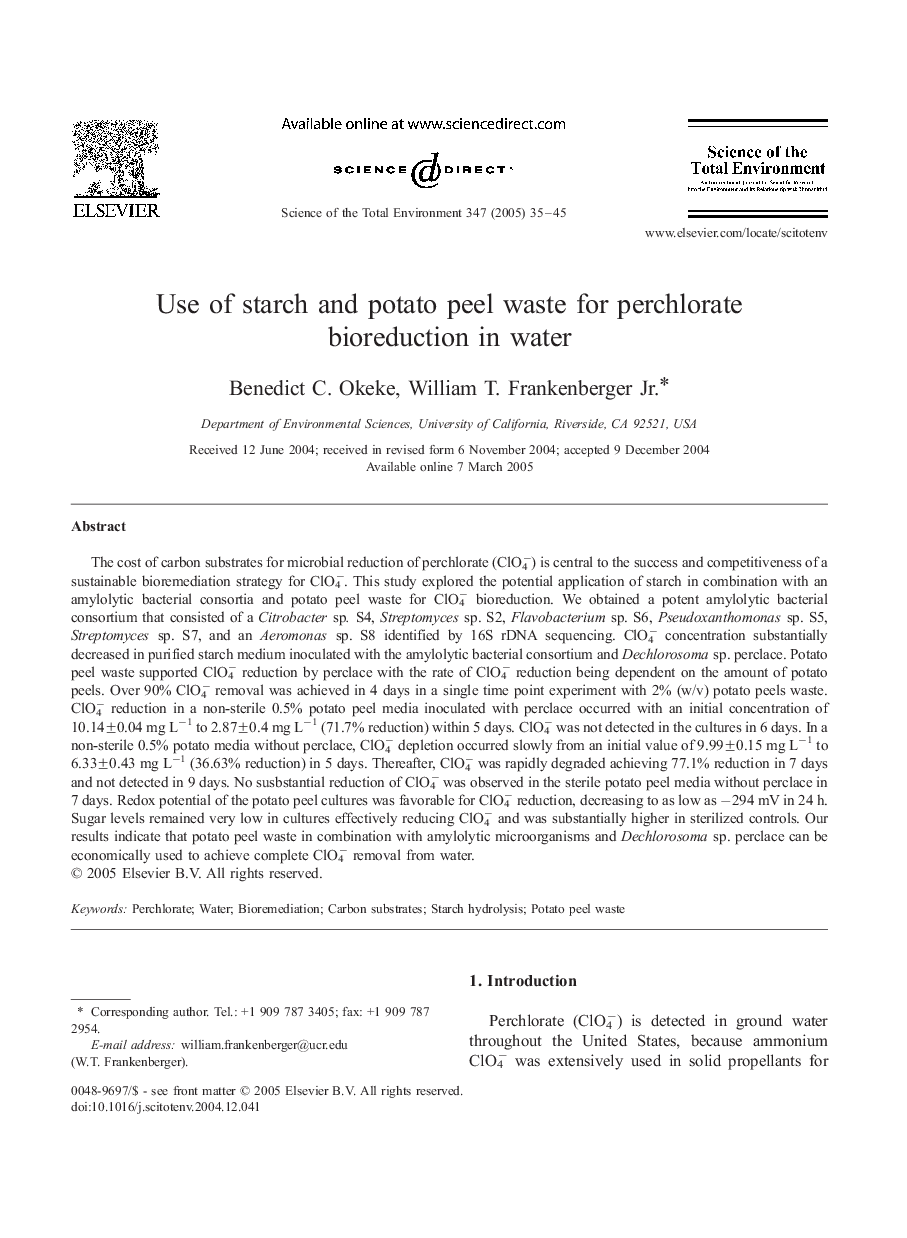| کد مقاله | کد نشریه | سال انتشار | مقاله انگلیسی | نسخه تمام متن |
|---|---|---|---|---|
| 10110668 | 1619991 | 2005 | 11 صفحه PDF | دانلود رایگان |
عنوان انگلیسی مقاله ISI
Use of starch and potato peel waste for perchlorate bioreduction in water
دانلود مقاله + سفارش ترجمه
دانلود مقاله ISI انگلیسی
رایگان برای ایرانیان
کلمات کلیدی
موضوعات مرتبط
علوم زیستی و بیوفناوری
علوم محیط زیست
شیمی زیست محیطی
پیش نمایش صفحه اول مقاله

چکیده انگلیسی
The cost of carbon substrates for microbial reduction of perchlorate (ClO4â) is central to the success and competitiveness of a sustainable bioremediation strategy for ClO4â. This study explored the potential application of starch in combination with an amylolytic bacterial consortia and potato peel waste for ClO4â bioreduction. We obtained a potent amylolytic bacterial consortium that consisted of a Citrobacter sp. S4, Streptomyces sp. S2, Flavobacterium sp. S6, Pseudoxanthomonas sp. S5, Streptomyces sp. S7, and an Aeromonas sp. S8 identified by 16S rDNA sequencing. ClO4â concentration substantially decreased in purified starch medium inoculated with the amylolytic bacterial consortium and Dechlorosoma sp. perclace. Potato peel waste supported ClO4â reduction by perclace with the rate of ClO4â reduction being dependent on the amount of potato peels. Over 90% ClO4â removal was achieved in 4 days in a single time point experiment with 2% (w/v) potato peels waste. ClO4â reduction in a non-sterile 0.5% potato peel media inoculated with perclace occurred with an initial concentration of 10.14±0.04 mg Lâ1 to 2.87±0.4 mg Lâ1 (71.7% reduction) within 5 days. ClO4â was not detected in the cultures in 6 days. In a non-sterile 0.5% potato media without perclace, ClO4â depletion occurred slowly from an initial value of 9.99±0.15 mg Lâ1 to 6.33±0.43 mg Lâ1 (36.63% reduction) in 5 days. Thereafter, ClO4â was rapidly degraded achieving 77.1% reduction in 7 days and not detected in 9 days. No susbstantial reduction of ClO4â was observed in the sterile potato peel media without perclace in 7 days. Redox potential of the potato peel cultures was favorable for ClO4â reduction, decreasing to as low as â294 mV in 24 h. Sugar levels remained very low in cultures effectively reducing ClO4â and was substantially higher in sterilized controls. Our results indicate that potato peel waste in combination with amylolytic microorganisms and Dechlorosoma sp. perclace can be economically used to achieve complete ClO4â removal from water.
ناشر
Database: Elsevier - ScienceDirect (ساینس دایرکت)
Journal: Science of The Total Environment - Volume 347, Issues 1â3, 15 July 2005, Pages 35-45
Journal: Science of The Total Environment - Volume 347, Issues 1â3, 15 July 2005, Pages 35-45
نویسندگان
Benedict C. Okeke, William T. Jr.,